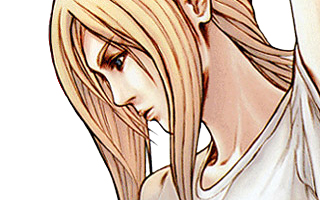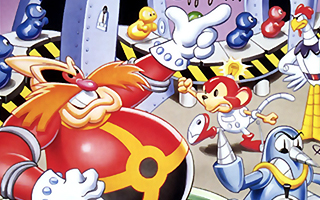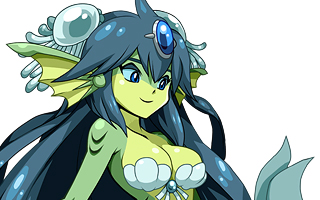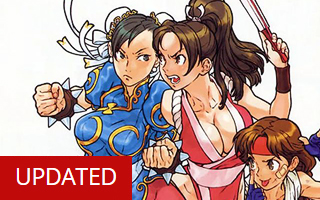PC-98
Top 10 Best PC-98 Games of All Time!
Before Windows 95 was released, the PC-98 was the business computer of choice in Japan. Since it featured higher resolutions than typical computers of the era, it was better-equipped to handle Japanese text. The computers naturally became popular with game developers as well, and its architecture made it a perfect platform for adventure games, RPGs, dating sims, and other genres that relied heavily on text. Its large install base was able to support thousands of games, and a steady flow of fan-made titles kept the community engaged for decades. The PC-98 library is particularly noteworthy for its abundance of eroge content, and the machines were the most prominent smut delivery systems of their day. H-games were released by the hundreds on the PC-98! If naked anime babes aren’t your thing, then I suggest you tread lightly if you intend on researching the system further. For the purpose of this list, we’ll try to avoid mentioning any games that had been previously released on the PC-88.
10
Chitty Chitty Train
1993

Chitty Chitty Train is difficult to describe because there aren’t really a lot of games like it. It’s basically a real-time train-routing puzzle game. Your objective is to watch over trains as they move along the map and prevent any derailments from taking place. Players aren’t given any control over the trains themselves, and instead direct them by operating switches placed at various intersections. It’s a simple concept, but the trains move very quickly so its almost impossible to plan ahead. You have to watch over multiple trains at the same time, and the courses have many paths for the trains to take. Even though the switches are controlled by a simple mouse click, it’s hard to keep up with the action. It’s possible to slow trains down momentarily by placing stop lights on the map, but this often causes other trains to crash into them. You’ll inadvertently cause thousands of derailments when playing the game, but the upbeat music helps lighten the mood. Chitty Chitty Train has the happiest music this side of Bubble Bobble.
9
Rude Breaker
1996

Rude Breaker is seldom mentioned on the Internet and even Wikipedia seems to be unaware of its existence. The reason for its obscurity is because it was released exclusively for a disk-based magazine from Compile known as Disc Station. This magazine often featured demos and previews, and there were also a handful of games that could only be found on Disc Station volumes. At the risk of sounding like a broken record, Compile pretty much dominated the world of vertically-scrolling shooters. Regardless of what system they were working on, they always seemed to push the hardware further than other developers could. Rude Breaker was no exception. The game moves fast, the scrolling is smooth, and there’s no slowdown even when the screen is filled with enemy ships. I’d be remiss not to mention that the game’s soundtrack is almost as intense as the action is. Like most Compile shooters, Rude Breaker gives players a wide range of weapons to use and many opportunities to upgrade them. Rude Breaker is a lot more accessible than most shooters because getting shot by an enemy doesn’t result in instant death. Instead, it simply causes the player to lose their sub-weapons. Unfortunately, this makes the game a little too easy. There are only five stages and the game can be completed in a half hour with relative ease, but it’s always fun to jump into.
8
Flame Zapper Kotsujin
1996

Flame Zapper Kotsujin is one of many fan-made (or “dōjin”) games that was released on the PC-98. You’d never guess by looking at it, but the game was made by a team consisting of only two developers. The game still manages to outperform the vast majority of games on the platform. The graphics are detailed, the music is intense, and the gameplay is way smoother than most shooters on the PC-98 were. Flame Zapper Kotsujin is fairly generic, but I mean that in the nicest way possible. Many other shoot ’em ups on the PC-98 had gimmicks to help them stand out. Galt-Rio was a story-driven shooter that bombarded players with walls of text while Steam-Heart’s featured naked catgirls. Flame Zapper Kotsujin sticks with the fundamentals. You fly a spaceship, collect power-ups, and take down massive bosses. The concept is pretty simple, but the game is extremely challenging. The game could be classified as a “bullet hell” shooter and throws a ridiculous number of enemies and projectiles at the player. There are cool weapons to obtain (including homing lasers and various types of bombs), but the focus is on avoiding bullets rather than destroying enemies.
7
46 Okunen Monogatari
1990

46 Okunen Monogatari ~The Shinka Ron~ (literally 4.6 Billion Year Story ~The Theory of Evolution~) is an ambitious RPG from Enix that spans many eons. The story begins with primordial oceans, takes us through the age of the dinosaurs, and eventually winds up in a desolate awesome future with goblins and space elves. You’ll start off as a primitive fish, and you’ll evolve into stronger (and smarter) creatures as the story progresses. It’s an ambitious concept based on complex scientific theory, but it also features fantastical elements like goddesses, demons, and reptilian aliens from the Moon. Needless to say, the game doesn’t get weighed down by the details. The battle system makes Dragon Quest seem complicated in comparison, and players don’t even have to worry about equipment or inventory items. Many of the fights will be over within a matter of seconds! If you manage to survive an enemy encounter, you will be rewarded with “evolution points” in lieu of traditional experience points. These points can be used to increase various stats, and the decisions you make have a meaningful impact on how your adventure will unfold. In most RPGs, leveling up usually results in a few arbitrary numbers increasing. In 46 Okunen Monogatari, you’ll actually evolve into entirely new creatures. There are dozens of creatures you can potentially evolve into, and it’s a lot of fun to test your new skills along the way. As with most JRPGs, you’ll likely have to spend some time grinding. This aspect of the game fits nicely with the overall theme, however, since evolution is a slow and incremental process by nature. 46 Okunen Monogatari was given a SNES sequel called E.V.O.: The Search for Eden, but I wasn’t even aware that the original game existed. Fortunately, the game started developing a larger following after fans released an English translation patch in 2017. I overlooked the game on an earlier iteration of this countdown, but I think it’s only appropriate for the list to evolve over time.
6
Policenauts
1994

Policenauts is a graphic adventure game and the spiritual successor to Snatcher. Some will debate whether graphic adventures and visual novels can even be considered games in the first place, but there is no question that they helped define the PC-98. Policenauts uses a menu-driven interface that allows the player to talk, examine, and investigate in order to gather information. The point-and-click gameplay is pretty limited, but the real draw of the game is the compelling storyline and intriguing characters. The game was written and directed by Hideo Kojima and adopts a hard science fiction storyline in lieu of the cyberpunk motif employed by Snatcher. Many allusions to past works are made, and the main characters bare strong resemblances to Riggs and Murtaugh from Lethal Weapon. The story itself is a lot more straightforward than most of Kojima’s games, but the characters are memorable and the world is interesting. Players spend most of the game investigating a murder, but the “buddy cops in space” dynamic keeps things lighthearted.
5
YU-NO
1996

YU-NO is a visual novel developed by ELF. This means that you can expect to see a plethora of panty shots and awkward sexual encounters throughout the game. (The taboo-breaking third act is downright depraved.) Beneath the erotic content, the game deals with complex issues like mathematics, philosophy, history, and religion. YU-NO takes a creative approach to storytelling and is a lot more engaging than typical visual novels. Games with branching dialogue trees often leave players wondering how things would have turned out if their responses had been different, but the time traveling dynamic in YU-NO gives players the chance to explore these possibilities. Being able to jump back to previous events and discussions essentially lets players rewrite history. One of the most compelling aspects of the game is how the timeline is physically mapped out. Players are given a visual representation of how their choices in the game are leading to alternate realities. It would be easy to write the game off due to its porny exterior, but YU-NO was a revolutionary visual novel with intriguing characters, a compelling storyline, and one of the best soundtracks to grace the PC-98.
4
Night Slave
1996

Night Slave is a side-scrolling action game that borrows heavily from Cybernator on the SNES. The game puts players in control of large mechs and takes them through environments ranging from rainy jungles to alien bases. The variety of stages is impressive, and each area of the game looks completely different from the next. The attention to detail in the backgrounds and the quality of the sprite animations go beyond what you’d expect to see in a typical PC-98 action game. The most interesting aspect about the game is its Gradius-inspired upgrade system. By obtaining orbs throughout the game, players can improve their shields, increase their health, or level-up their weapons. These light RPG elements add a lot of depth to what would otherwise be a fairly straightforward action game. Upgrading the mechs actually changes their appearance in the game, and this ultimately makes your progress feel more significant. Another noteworthy aspect about Night Slave is the graphic depictions of lesbian bondage that are shown between each stage. These adult cutscenes don’t add a lot to the game and can be turned off entirely, but I’m not complaining either way. Giant mechs and hot lesbian action sounds like a winning combination to me!
3
Rusty
1993

If you were to take Castlevania and replace Simon Belmont with a leather-clad dominatrix, you’d end up with Rusty. This isn’t a bad thing. Who wouldn’t want to play a game with energetic music, impressive boss battles, and a badass whip-wielding protagonist? It would be easy to label the game as a sleazy knock-off and call it a day, but there are a number of things that help Rusty stand out from the game it was inspired by. The levels in Rusty are more complex than they are in Castlevania and provide more pathways to explore. Springboards and conveyor belts allow for some simple environmental puzzles, and there are a lot of secrets to find in each stage. The game is noticeably faster than Castlevania too, and the inclusion of a run button makes this even more apparent. Players will need this extra boost of speed to clear large jumps, avoid falling ceilings, and get across collapsing bridges. The game also included a cool eagle sidekick who would attack enemies on your behalf. (This was years before Symphony of the Night introduced familiars to the Castlevania franchise.) The animation is somewhat wooden at times and some of the areas feel a little empty, but Rusty is easily one of the best games released exclusively for the PC-98 and the type of game that western audiences would have gravitated to.
2
Mystic Square
1998

The most notable franchise to debut on the PC-98 was a series of five dōjin games collectively known as the Touhou Project. These games were made by a one-man team and helped define the concept of “bullet hell” shooters. The series has gained enough notoriety for Touhou Project to be inducted into the Guinness World Records as the “most prolific fan-made shooter series.” (What an oddly specific category.) Touhou games are famous for featuring a cast of characters comprised entirely of little girls. Despite its harmless exterior, the games are also notoriously difficult. The first several games in series were a little rough around the edges, but the franchise found its identity in the fourth and fifth games. To date, over 20 Touhou games have been released. Mystic Square was the final Touhou game released on the PC-98 and featured gameplay similar to its Windows-based sequels. The music is upbeat and the graphics are adorable, but the game is agonizing. The game looks like an explosion of color due to the staggering amount of enemy projectiles and explosions on screen at any given time. If dodging the projectiles wasn’t difficult enough, the game also encourages players to take risks by offering more points for collecting items near the top of the playing area. With the exception of pornographic adventure games, no genre defined the PC-98 more than dōjin shooters. This list simply wouldn’t have been complete without Touhou. Singling out the best Touhou game on PC-98 is like opening a can of worms, but Mystic Square simply feels more refined than its predecessors.
1
Puyo Puyo 2
1995

Given their reputation for intense action games, it seemed like a pretty big departure when Compile entered the puzzle game arena. The gameplay in Puyo Puyo was a lot more action-oriented than typical Tetris clones from the era, so it wasn’t as big of a leap as you might think. The basic premise revolves around colored blobs that fall from the ceiling. By grouping these blobs by their color, players can eliminate them from the playing field. Similar to Dr. Mario, players can set up combination moves to clear several groups at once. By executing combos, players will cause garbage blobs to fall on their opponent’s screen. This creates an interesting risk/reward dynamic. Chaining together combos requires a certain amount of planning, but these plans could easily be ruined if your opponent drops garbage blocks on you before you can act on them. The original Puyo Puyo was a huge success, but the sequel took the video game world by storm when it hit Japanese arcades in 1994. It became one of the most popular games of the era and was subsequently ported to nearly a dozen different gaming platforms. Puyo Puyo 2 on the PC-98 was basically a bare-bones port of the original arcade game, but the FM synth soundtrack made it stand out. Puyo Puyo 2 is the best puzzle game on the system by a comfortable margin and holds up better than almost every other PC-98 game.





Do you agree with this list? Let us know what you think by leaving a comment below. Your opinion matters!